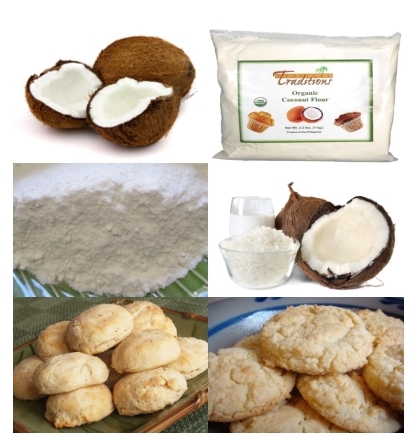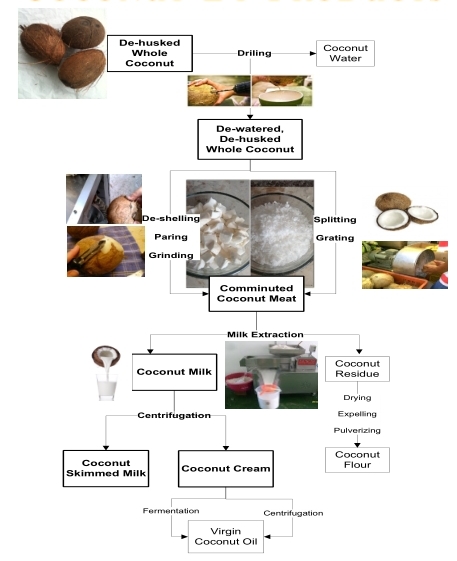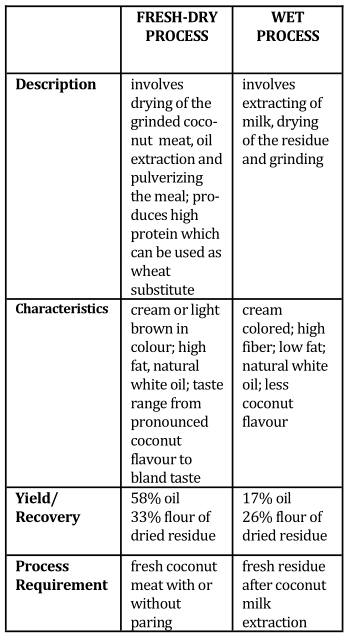Coconut flour refers to the screened food-grade product obtained after drying, expelling and/or extracting most of the oil or meat from coconut meat. The granulation is dependent upon the degree of grinding and meshing to which the raw material has been subjected and varies from 30-250 mesh. Coconut flour is proven to contain dietary fiber.

TYPES OF COCONUT FLOUR
Coconut Flour, Whole Full Fat is prepared from unpared, dehydrated and edible coconut kernels by pre-pressing and solvent extraction.
Defatted Coconut Flour/Food-Grade Copra Meal is obtained from food grade copra that has been defatted by solvent/mechanical extraction. The resulting flour is brownish in colour because the kernel is not pared. Sub classified into: low fat (10-15%); medium fat (16-25%); high fat (25-48%).
Low Fat, High Fibre Coconut Flour is coconut flour made from finely ground coconut residue with a fat content of 10-15%.
High Protein, Low Fibre Coconut Flour is enzyme-translated coconut flour made from finely ground residue.
Paring Flour is prepared from the paring of the coconut.
Copra Meal is coconut meal obtained after extracting oil from granulated copra.
Copra Meal is coconut meal obtained after extracting oil from granulated copra.
Process Flow of Coconut By-Products

Drying – involves removing of water from the food product into the surrounding air
Expelling – extracting the oil from the dried coconut residue
Pulverizing– crashing of the coconut flakes resulting in a powder-like form
Production Process
The manufacturing of coconut flour involves two processing methods either by Dry Process or by Wet Process. Below is the summary of the processing methods.

Classifications
Premium Class – white to creamy white color; fine particle size (0.15-0.20 mm)
Class I (Good Quality) – very light brown in color; medium particle size (0.21-0.25 mm)
Class II (Fair Quality) – very light brown to brown color; medium particle size (0.21-0.25 mm)
Uses and Health Benefits
High-protein coconut flour can be used as substitute for wheat flour in breads and cakes; can also be used in nutrition feeding programs.
Coconut flour has been proven to have high amounts of soluble and insoluble dietary fiber (49% – 60%) which is important in functional food development. (Based on the study made by PCA).
Test foods containing 15% – 25% dietary fiber from coconut flour reduces serum total and LDL cholesterol of humans with moderately raised serum cholesterol.
High-fiber coconut flour is used as food supplement/additive in breads, cookies and snack food to provide dietary fiber sources. It is also used as fiber food to help in preventing constipation and as fiber food for patients with diabetes and moderately raised cholesterol levels.
Coconut flour can also be used as fillers for emulsified products such as sausages, meat loaf and burger patties.
Several recipes were prepared utilizing 5%-25% coconut flour which were found acceptable.
FOOD PRODUCT DEVELOPMENT DIVISION
Research and Development Branch
Philippine Coconut Authority
FPDD Plant, PCA Cmpd., Elliptical Road
Diliman, Quezon City
Tel. No.: (+632) 928-4501
Fax No.: (+632) 926-7631
Email: [email protected]
Source: Philippine Coconut Authority

